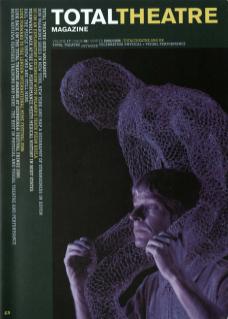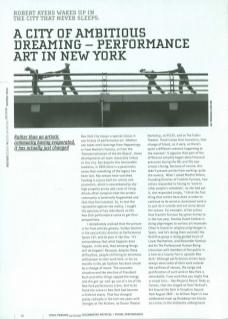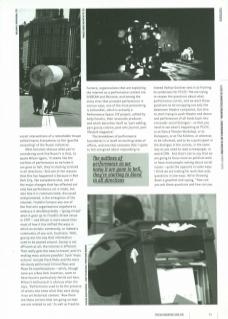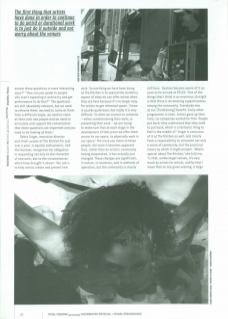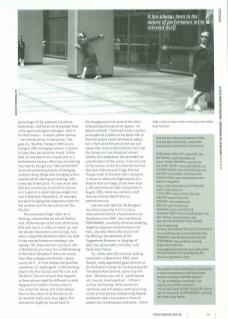New York City enjoys a special status in any history of performance art. Whether one takes one's bearings from Happenings, or from Warhol's Factory, or from the 'Dematerialisation of the Art Object', these developments all seem inexorably linked to this city. But despite this honourable tradition, in 2005 there is a pessimistic sense that something of the legacy has been lost. Key venues have vanished. Funding is scarce both for artists and promoters, which is exacerbated by sky high property prices and costs of living. Artists often complain that the artistic community is terminally fragmented and that they feel isolated. So, to test the reputation against the reality, I sought the opinions of key individuals on the New York performance scene to get their perspectives.
I immediately realised that the picture is far from entirely gloomy. Vallejo Gantner is the new artistic director at Performance Space 122, and he puts it like this: 'It's extraordinary that what happens does happen, in the end, that amazing things still do happen.' Because, despite these difficulties, people still bring an enormous enthusiasm to their work here. In his six months in the job Gantner has been struck by a change of mood: 'The economic situation and the election of President Bush and other things sapped the energy and the get-up-and-go out of a lot of the New York performance scene. And to be frank the scene in New York had become a little bit static. That has changed pretty radically in the last two years with changes at The Kitchen, at Dance Theater Workshop, at PS122, and at The Public Theater. There's been that transition, that change of blood, as it were, so there's quite a different scenario happening at the moment.' It appears that part of the difference actually began when financial pressures during the 80s and 90s saw venues closing, because of course, this didn't prevent artists from working: quite the reverse. When I asked Martha Wilson, Founding Director of Franklin Furnace, how artists responded to having to 'work to other people's schedules', as she had put it, she responded simply, 'I think the first thing that artists have done in order to continue to do weird or durational work is to just do it outside and not worry about the venues. For example, of the artists that Franklin Furnace has given money to in the last year, Nicolás Dumit Estévez is doing pilgrimages to various art museums (they're based on religious pilgrimages in Spain, and he's doing them outside), the Red Dive group is doing guided tours of Lower Manhattan, and Alexander Komlosi did his The Professional Human Being interviews with members of the public in a tent at a County Fair in upstate New York.' Although performance artists have always done some of their work outside the confines of venues, the range and proliferation of such work in New York is remarkable. From work that you might find in street fairs – like Marjorie Kouns' Body as Canvas, that she staged at Howl festival's Art Around the Park in Tompkins Square Park August 2005 – to William Pope L's now celebrated crawl up Broadway ten blocks at a time; to the elaborate underground social interventions of a remarkable troupe called Improv Everywhere; to the 'guerilla consulting' of the Nsumi collective.
What becomes obvious when you're considering work like Nsumi's is that, to quote Wilson again, 'It seems like the outlines of performance as we knew it are gone to hell, they're starting to bleed in all directions. And one of the reasons that this has happened is because in New York City, like everywhere else, one of the major changes that has affected not only how performance art is made, but also how it is communicated, discussed and promoted, is the emergence of the internet. Franklin Furnace was one of the first arts organisations anywhere to embrace it wholeheartedly – going virtual when it gave up its Franklin Street venue in 1997 – and Wilson is more aware than most of how it has shifted the ways in which an artistic community, or indeed a community of any sort, functions: 'Well, gossip was the way that information used to be passed around. Gossip is not efficient at all; the internet is efficient. That really gets the news to travel, and it's making mass actions possible.’ Such 'mass actions’ include Flash Mobs and the more obviously politicised Critical Mass and Move On manifestations – which, though none are a New York invention, seem to have found a particularly fertile soil here. Wilson's enthusiasm is obvious when she says, 'Performance used to be the preserve of artists who knew what they were doing in an art historical context. Now there are these actions that are going on that are not related to art.' As well as Franklin Furnace, organisations that are exploiting the internet as a performance context are EYEBEAM and Rhizome; and among the many sites that promote performance in various ways, one of the more persevering is Culturebot, which is actually a Performance Space 122 project, edited by Andy Horwitz, their associate producer, and which describes itself as 'part weblog, part gossip column, part arts journal, part lifestyle magazine'.
This breakdown of performance boundaries is in itself an exciting state of affairs, and one that everyone that I spoke to felt energised about responding to.
Indeed Vallejo Gantner sees it as framing his ambitions for PS122: ‘We are trying to reopen the questions about what performance can be, and we want those questions to be occupying not only the downtown theatre companies, but also to start trying to push theatre and dance and performance of all kinds back into a broader social dialogue – so that you need to see what's happening at PS122, or at Dance Theater Workshop, or at Danspace, or at The Kitchen, or wherever, to be informed, and to be a participant in the dialogue in the society, in the same way as you need to read a newspaper, or watch CNN. And that's not to say that we are going to focus more on political work or have more people ranting about social issues – quite the opposite in some ways. I think we are looking for work that asks questions in new ways. We're throwing down a gauntlet and saying, "How can you ask these questions and how can you answer these questions in more interesting ways?" "How can you speak to people who aren't expecting it and to try and get performance to do this?" The questions are still absolutely relevant, but we need to reframe them, we need to come at them from a different angle, we need to come at them with new people and we need to articulate and support the conversation that these questions are important and you need to be looking at them.’
The outlines of performance as we knew it are gone to hell, they're starting to bleed in all directions.
Debra Singer, executive director and chief curator of The Kitchen for just over a year, is equally enthusiastic, and like Gantner, recognises her obligation in responding not only to the character of new work, but to the circumstances which have brought it about: 'Our job is to help artists create and present new work. So one thing we have been doing at The Kitchen is to expand the residency aspect of what we can offer artists when they are here because it's no longer easy for artists to get rehearsal space. I know it sounds quite basic but really it is very difficult. So when we commit to someone – either commissioning their work, or presenting their work – we are trying to make sure that at each stage in the development of that piece we offer them access to our space, to physically work in our space. The more you listen to these people, the more it becomes apparent that, rather than an artistic community having evaporated, it has actually just changed. These changes are significant, in nature, in locations, and in methods of operation, but the community is clearly still here. Gantner became aware of it as soon as he arrived at PS122: ‘One of the things that I think is an enormous strength is that there is an amazing supportiveness among the community. Everybody was at our [fundraising] benefit. Every other programmer in town. Artists gave up their time, six companies worked for free. People put back; they understand that they need to put back, which is a fantastic thing to feel in the middle of.' Singer is conscious of it at The Kitchen as well, and clearly feels a responsibility to stimulate not only a sense of community, but the practical means by which it might prosper. ‘What's special about The Kitchen,' she told me, 'is that, unlike larger venues, it's very much by artists for artists, and by that I mean that on any given evening, a large percentage of the audience are artists themselves, and those are the people that come again and again and again. And so for that reason – it seems rather obvious – we lowered all our ticket prices.’ She goes on, ‘Another change is that we are trying to offer emerging curators a chance to have their perspectives heard. In New York it's not easy to be a visual arts or a performance curator. When you are starting out, how do you get your ideas presented? So we are presenting events of emerging curators doing things with emerging artists: several artists sharing one evening, with a very low ticket price. It's very much that feel of a community of artists for artists, so it's part of a scene that you might find now in Bushwick [Brooklyn], for example, but we're bringing that experience both for the curators and for the artists into The Kitchen.'
The scene that Singer refers to is thriving, and one that we are all familiar with. Performances of all sorts often share bills with music or video or stand-up, and the venues themselves come and go, but, when I asked Martha Wilson where she went to see new performance nowadays, she replied, 'Oh, there are tons out there. Not in Manhattan any more, but in Williamsburg or Red Hook [Brooklyn] there are venues that show underground theatre, I guess you'd call it. It's not always real good but sometimes it's really good. In Williamsburg there's The Flux Factory and The Cave and The Brick.' The sort of work that happens in these places might be different to what happened at Franklin Furnace when it was a physical venue, but it has always been in the nature of performance art to reinvent itself, and, once again, this reinvention might be traced back to the disappearance of some of the older dedicated performance art spaces. As Wilson realised, 'I believed it was a serious philosophical problem to be dealt with so that the artists would not have to adapt, but in fact what the artists did was just adapt their work to deal with the fact that the venues are now theatrical venues.’ Indeed, this adaptation has provided not only the basis of this scene, it has also led to the success of the far more mainstream New York International Fringe Festival. Though much of the work that it presents is nearer to what one might expect of a theatre festival fringe, of the more than 1300 performances that it presented in August 2005, there was certainly stuff that was clearly identifiable as performance art.
Like the work that Dan McKereghan has been presenting in his Currency international festival of performance at Chashama since 2002. Like new festival PERFORMA05, curated by RoseLee Goldberg, long-time supporter of performance art here. Like what Marina Abramovic will be offering coincidentally at The Guggenheim Museum: re-stagings of what she, presumably ironically, calls Seven Easy Pieces.
So, rather than the situation looking pessimistic in New York in 2005, Mark Russell, newly appointed guest director of the Portland Institute for Contemporary Art Time Based Arts Festival, sum it up like this: 'Whatever you call it – performance art, live art, time based art – I think it is alive and kicking. Performance art continues and will always continue as long as the primal desires underpinning theater and dance and a live action in front of people has contemporary relevance. I think that need is even more necessary now than ever before.'
Find out more about performance in New York and about the artists, venues and organizations mentioned in this feature:
Performance Space 122: www.ps122.org
The Kitchen: www.thekitchen.org
Dance Theater Workshop: www.dw.org
The Public Theater: www.publictheater.org
Franklin Fumace: www.franklinfurnace.org
Red Dive: www.reddive.freeservers.com
Marjorie Kouns: www.marjoriekouns.com
Improv Everywhere: http://improveverywhere.com/home.php
Nsumi: www.nsumi.net
Critical Mass: www.criticalmass.org
Move On: www.moveon.org
EYEBEAM: www.eyebeam.org
Rhizome: www.rhizome.org
Culturebot: www.culturebot.org
Danspace Project: www.donspaceproject.org
Flux Factory: www.fluxfactory.org
New York International Fringe Festival: www.fringenyc.org
Currency international festival of performance: www.choshama.org/currency/cOxindex.htm
Chashama: www.chashama.org/home.php
PERFORMA05: www.performa-arts.org
Guggenheim Museum www.guggenheim.org/new_york_index.shtml
Portland Institute for Contemporary Art: www.pic.org/index_fl.html
All quotations taken directly from conversations or email correspondence with the persons involved, and used with their approval.
‘A City of Ambitious Dreaming' is an expression of Vallejo Gantner's. See the next issue of Total Theatre for Robert Ayers's discussion of PERFORMA05, Currency and Seven Easy Pieces.
